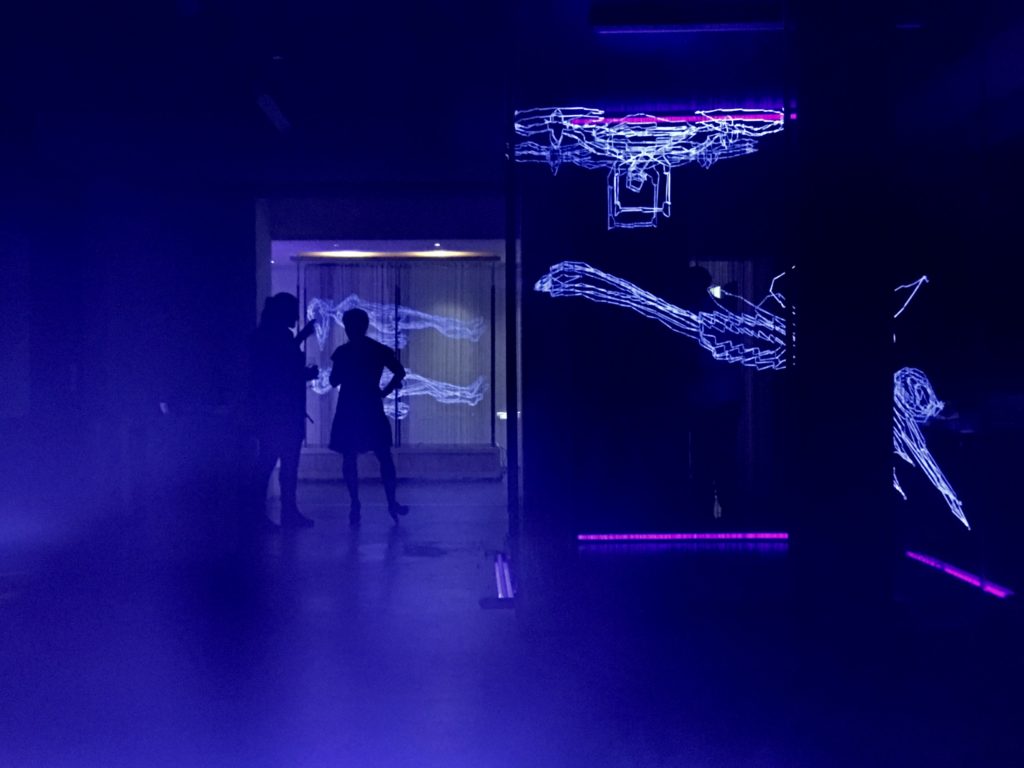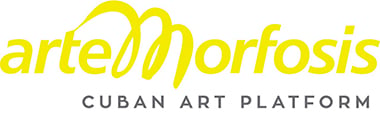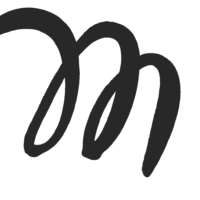Duvier del Dago – Interview by Virginia Alberdi
In the wide-ranging interview, renowned Cuban visual artist Duvier del Dago discusses his unique and intellectual artistry, the inspirations from his childhood and early education, and his experiences in the prominent Cuban art collective, Galería DUPP. He emphasizes the integration of historical events and collective memory in his work, indicating how these elements have come to shape his creative vision. Dago’s recent art exhibition in Zurich centers on the ethical implications of drone technology on society, embodying his ongoing fascination with the interplay between technology and nature. The show reflects Dago’s belief that all individuals are artists within their own historical moments, adding further depth to his vision of the world.

Duvier del Dago – Installations of series STANDBY during opening
MOST OF US ARE ARTISTS OF A HISTORICAL MOMENT
The works of Duvier del Dago stand out in the Cuban visual arts scene of the first two decades of the twenty-first century. He is a young artist who, in a relatively short time, has succeeded in articulating his own intelligent language, loaded with intellectual arguments understand-able by informed viewers who have studied art as well as those who approach a gallery for the first time or who encounter any of his works in public spaces. The visual impact of his work has a solid foundation in concepts about the art that Duvier del Dago has been developing since his years at the academy. In other words, we are facing an artist in whom theory and practice are articulated in a coherent exercise. Nothing is more appropriate, then, than to allow the creator to speak for himself about his education, motivation, and approach.
Let us start from the very beginning. Was there an element of creativity in your childhood surroundings?
There was someone who I think might have had a direct influence. That was Silvio Rojas, a friend and work colleague of my father. They worked together in the Department of Topography and Polygonal Plane Projects of the “Chiquitico Fabre gat” sugar mill in Zulueta, the island’s central region. It was Silvio who, year after year, from 1982 through 1991, designed the carnival floats for the neighbors of La Loma in the Parrandas (carnival) of Zulueta.
On the weekends my parents took me along when they got together with Silvio and his wife. Silvio perceived cer-tain aptitudes in me, and showed me the projects furtively, since these works were kept in total secrecy to increase the expectations for the popular event. I dreamed of those drawings and then, at home, reproduced fragments and created my own designs. My father took me to watch when the float construction began in the neighborhood, and that evidently had a big influence on me. Seeing how those sculptural pieces materialized from plan to real floats gathered in the streets and participating in the processions, helped me to develop my drawing skills and spacial imagination, as well as a sharp pragmatism when working with different materials and scales.
In 1990 Silvio finally entrusted me to design a boat for a float picturing the Blue Danube, and I could see it in the parrandas of that year. It was very gratifying. Those experiences were my first school.
From Zulueta you went to Trinidad, a city on the other end of the island’s central region, and then to the Higher Institute of Art (ISA) in Havana. How did you get there?
I learned that a new art school (“Oscar Fernández Morera”) had been opened in Trinidad and was trying to attract students to the country’s central region. Even though I had no previous art education, we succeeded in having my name included and I was accepted.
At that moment Trinidad seemed to me like the end of the world, but it was really the beginning of a path that formed me and completely changed my perspectives. I had excellent teachers and a small group of nine students in my year, and all were greatly focused on what they wanted to achieve: to study at ISA in Havana.
Studying there during that period of my life was an essential for my artistic education. There I read my first books, took part in the first group exhibitions, and absorbed the technical knowledge I have today. I had excellent teachers, such as Jorge Luis Rodríguez, Luis Blanco Rusindo, Guillermo Duffay, Daniel Acebo, Ania Delfín, Arocha, Mario Guerra, Miguel Rodríguez, and Osvaldo Alomá, among many others.
The entrance to ISA was the next step. You can imagine how important it was for us, coming from a school outside the capital, to achieve that goal. Havana, with its art scene, became like a classroom for that small group from Trinidad. We had moved to an eminently cultural city that put us in contact with other art forms and interdisciplinary projects. ISA prepared us even more in the conceptual aspect and in fully developing a personal style through the contact with important artists and professors such as René Francisco Rodríguez, Eduardo Ponjuán, Lázaro Saavedra, Belkis Ayón, and Ramón Cabrera Salort, among others.
1998 seems to have been an important date in your career.
Indeed, 1998 was very important in my career. I was in my second year at ISA. René Francisco had returned to teach at the institute and I was lucky to attend his painting lessons. We had already studied Thomas McEvilley’s method in the first year (On the Manner of Addressing Clouds, 1984) and we had reached a stage in which you had to create your personal discourse as artist, communicate with your own style, and find the way to solve your conceptual problems.
Our group gave birth to Galería DUPP (Desde Una Pragmática Pedagógica – based on pedagogic pragmatics)., which was another of the practical teaching methods organized by René Francisco to realize group projects, but always based on the individuality of each student. It was an eternal debate with René, who advocated group work as a far-reaching instrument, while some of us in the group always insisted in being part of a “group of individuals.”
Fortunately, our first undertaking as part of DUPP was a cycle of personal projects. This experience was profound for me: it was my first attempt to work as part of a duo with Omar Moreno (Omarito&Duvier); in a larger group of eleven artists; the first time I had a budget to produce works; and the first time my work was going to appear in public.
We worked hard. We created a routine: studying during the day and producing works at night to the rhythm of Cuba Tonight (the radio broadcast of Radio Taíno) and alternative rock cassettes. That discipline helped us advance quite rapidly.
As part of the duo, I involved Omarito in an investigation of those popular traditions I had been familiar with since my childhood. I had already presented a piece that was related to popular art for the exhibition at ISA during the Sixth Havana Biennial (Before the Rain). I had three Atlases made of papier-mâché supporting the weight of the gallery’s domes.
How did your artistic development continue? Aesthetically, what did you think should be changed?
I have experienced a flow of changes. In 2001 Omarito and I dissolved the duo Omarito&Duvier in order to graduate from ISA as independ-ent artists. It meant starting again with individual work. At school many were affiliated with Galería DUPP, but that project was also beginning to disintegrate. I retained the part that most interested me from the duo with Omar Moreno (stage dec-oration, installations and drawing) while Omarito continued to pursue what he had always preferred (digital and film work).
As for aesthetic solutions, when I graduated from ISA I was not considering disruption or changes. But I did expect a change in the institutional commitment toward visual arts. In those days I applied for many scholarships and international residences. One of the things I wanted to see changed in the visual arts landscape in Cuba is the emergence of programs in support of works and projects, scholarships and art residences, which we always missed in the middle and higher levels of school. In 2001 there was not a single scholarship or residence for young artists in Cuba.
Tell us about your experience in Galería DUPP.
DUPP prepared me for many things: presenting projects, proposing an exhibition, collaborating with colleagues, utilizing various forms of installation and visual solutions, and promoting and documenting an event (because without the documentation of a project there is no memory). I also learned that without personal vision and commitment it is unlikely that a group concept will emerge. I think each group project can be strong as long as the contributions of its members are strong.
Galería DUPP was a once in a lifetime experience. There was no way that you could avoid getting totally involved. We became better friends than we already were, and every one of us is marked by that period. René Francisco and Lidzie Alvisa opened their home to us as general headquarters outside the ISA.
I invite you to take a retrospective look at your work, based on four solo shows: Mi mejor estrella no es un actor, sino un reproductor (My Best Star Is Not an Actor but a Player) (2001), Flashback (2004), Memory Stick (2008) and Caja negra (Black Box) (2009). How would you define your evolution in those stages?
With the presentation of my graduation project in Galería 23 y 12 (Mi mejor estrella…) I was trying to present myself as an artist, no longer as part of the Omarito&Duvier duo or of the Galería DUPP group.
In the project I tried to destroy the traditional protocols on how to present a graduation thesis, and that helped me very much in the conceptual part, as well as for my self- discovery. In the first place, there was the fact that the thesis would not be discussed standing in front of the board of examiners. I prepared an outline that was interpreted by an actor, whose role was to convey all my formal and conceptual concerns toward the work of art. That outline was an interview with this androgynous character that would be recorded in a real studio and transmitted by the local TV network. In that way it would be seen in the gallery on a TV set that was part of the exhibition, and at the same time in all those places where that channel was tuned at the moment of the interview. That was my original idea.
Ultimately and not surprisingly, I was not allowed to do it on the national TV network. I then adapted the idea: I recorded the interview at the “El Ciervo Encantado” Theater at ISA, with the two actors (the player and the journalist). That recording was transmitted during the exhibition. In addition the ENEMA collective offered me the possibility to publish the outline as a comic strip. In that way the thesis would have a higher visibility than a document locked inside a library drawer.
In this exhibition I experimented with my first drawings on nylon in three-dimensions . I made structures from which the nylon layers hung in such a way that the superposition between them completed a given figure. This was the predecessor of a large part of the work I have been developping subsequently. Those drawings were displayed throughout the entire gallery as columns, on the walls there were expanded numerical combinations forming two-dimensional figures with threads. This showcase was my first attempt with thread sculptures and, though unsuccessful, it was very important for the work I was interested in creating.
After I graduated I began teaching at ISA as part of my Social Service. During that time I organized another solo show: Flashback in Galería Habana. I used a multitude of media: installation, drawing, light box, and sculpture. The main achievement was my first installation using thread, which impressed the visitors.
I had spent time investigating how to knit thread sculptures and built a representation of two cattle jaws facing each other, as in a dialogue. I managed to hold the figures in space using guiding lines traced with the threads themselves. At that moment I still hadn’t succeeded in highlighting the figures, so one saw a white framework in which the jaws were stretched. I added an art video which was displayed by a television positioned inside the installation. It contained six or seven video fragments, edited at different rhythms so that the image disappeared and reappeared intermittently. It was like a conversation with spaces of silence and more or less intense dialogues. The video was a necessary complement with which I continued to work afterwards, and as the technology advanced I projected it directly onto the thread pieces.
Between Flashback and Memory Stick I presented the solo show Espectador (Spectator, 2006) in Galería Servando, where I improved the technique of thread sculptures. That same year I was invited to the official show-case of the Ninth Havana Biennial, where I built the installation Bungalow in the moat at La Cabaña. With it I experimented taking this type of thread piece to a large scale and to the exteriors.
The three- dimensional drawing work had reached a good degree of maturity. I had already created natural, architectural and mechanical figures. Then I decided to reconstruct scenes from photos of my family. The showcase consisted of paintings and three knitted installations; two of them reintroduced video.
By that time I had already found the way of highlighting the drawing on the guiding lines using ultraviolet light that, when reacting with the white thread, allowed a perfect view of the silhouette. As to the production, it was an exhibition that had everything. I was able to paint the gallery in black to create the adequate environment in which to show the illu-minated pieces for the first time, and finally achieve the holographic effect I wanted for my works. Memory Stick also broke with the normal exhibition hours in Havana, since the showcase remained lit after closing hours and could be seen all night long through the display windows of the gallery. I hung black curtains to keep the halls dark during daytime and allow the sight of the pieces when opening them at night. Thus, it would not only have a more “spectacular” character seen from many angles of the crowded corner of 23rd and 12th, but it attracted all sorts of people.
The attendance was a complete success and set the basis for my next project at the Tenth Havana Biennial (2009), Caja negra (Black Box). The representation of a full scale F22 Raptor military aircraft was the opportunity to challenge this technique in an open, exterior and public space for a month.
History and memory appear as constant elements in your artistic projection, particularly in recent years. Does that have to do with your personal identity, with the concerns of your generation, or with the distinctive ups and downs of your country?
In recent years I have put special emphasis on these two topics within my work, which have been developing since Flashback in 2004.
It has to do with all three aspects of your question. I live the present with great intensity and thus regard it to be particularly important. What you do in the present will determine what represents your past or how far you can go in the future.
We are a generation permeated by historical events and live in a country with an ever so often told, very eventful and interesting history. Yet the stories do not satisfy: there are spaces of silence and emptiness as rich or richer than those reiterated inside and outside of Cuba.
As to the context, something interesting happening in Cuba: our daily reality is difficult to describe, one has to live it in order to understand it. There is no reliable continuity, and frequently we see ourselves forced to exaggerated improvisations even in the most trivial daily activities. That makes us all artists of a historical moment.
One of the projects where these constant elements are best reflected is the series La Historia es de quien la cuenta (His-tory Belongs to the One Who Tells It), on which I have been working since 2014. Originally the characters focused on what surrounded Cuba as social, political and economic phenomenon. Then I transferred those themes to the figure “The Republic”, an instrument through which I would continue commenting on the country’s new contextual circumstances.
This project is linked to two previous series, Secreto de Estado (State Secret) and Icono-grafía política (Political Iconography), on which I had been working and which were never exhibited in Cuba. This period of my work in painting and drawing was particularly marked with self-censorship.
Once you said, “The open space allows you to dream about other things.” How do you solve the dichotomy between the art exhibited in galleries and art in public spaces?
I am really much more interested in public spaces, since they are not connected with a visual arts’ organized circuit. I like them because I am greatly interested in the original function of the building, square, or plot. And although they may be galleries in the true sense, few were constructed with the initial purpose of becoming exhibition spaces. In general, a gallery is created in an existing space, an old store, dwelling, school, or hotel. And I love the fact that the place itself already has an added concept, and that when the exhibit or work is installed that concept may be reactivated or a new one may emerge.
Another aspect that the public space offers is all kinds of spectators, whether or not they are experts. Unfortu-nately, sometimes a stale environment is created in the gallery that makes both the work and the artist predictable. That must be eliminated if we truly want to make a sincere work. Similarly, there are works that are only adequate for a gallery space. The effectiveness lies in selecting very carefully the space in which you wish to show a work, and vice versa, in creating the work with the space in mind.
Everyone recognizes you are an excellent draftsman, but also an artist who experiments with installation. Is this a paradox or not?
Yes, it’s paradoxical. Many spectators who know me for my “threads” are totally unaware of my drawing and painting work. They assume I did not study art, but engineering, computer science, architecture, or design because the visual nature of my work somehow intertwines with these disciplines. Many people assume the pieces with threads emerge from some software where I mold them in 3D, but that is not the case. In fact, everything starts with a drawing. My interest in installations with threads appeared precisely because I wanted to place the drawing in a different dimension; hold it in space. Behind those knitted sculptures are many hours of drawing. When I started building them I had to make many calculations: how many meters of thread? How many eyebolts? Now it’s much easier because I already know the technique. But the drawing is still there; it all starts with an initial sketch, the next step is a plan on graph paper, followed by the patterns with the key points to weave the figure. For me, drawing is essential for the process.
What will you show in Zurich? Do you have expectations?
I intend to merge installations and drawings on a subject that has aroused great controversy internationally: the use of civilian drones and the norms for their use. I want to examine the ethical and moral values affected by the uncontrolled use of that technology. The effect of technology on man and nature is one of the themes reflected in my exhibition. At a metaphorical level I have solved it with the physical confrontation between natural elements and artefacts or machines of war. I am interested in examining who controls whom, and with what methods. I will also address the topic of social networks.
I am going to reword a question I asked you before. How do you value contemporary Cuban visual arts? What should change and how are you involved in that process of change?
Right now there is an artistic context in which many artists, including myself, understand that the solution was not to make Cuban art from a distance but in Cuba. Many of those who lived abroad have been returning, if not to remain permanently, at least increasing their presence at the Havana Biennial or in personal and group projects in the Island. Actually, the current situation is really not good, but as artists we will always try to produce work. On the other hand, there is no creativity where all needs are met.
I think that a way of involving oneself is precisely by staying active and trying to sustain work that raises questions in the viewer. For now I intend to return to ISA as a teacher. I will try to guide as best as I can, whether through teaching or my own work. I was a teacher at ISA for ten years (2001 -2011), and it is gratifying to learn about young artists who are successful and to know that you had something to do with that process, even if only with a piece of advice.
Virginia Alberdi, Havana, April 2017







